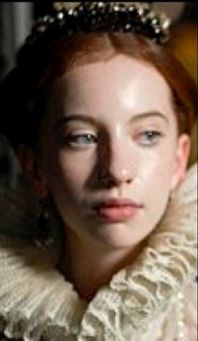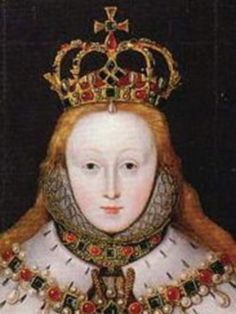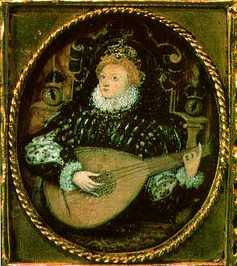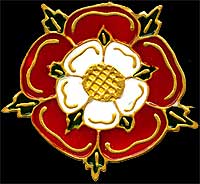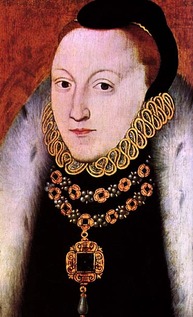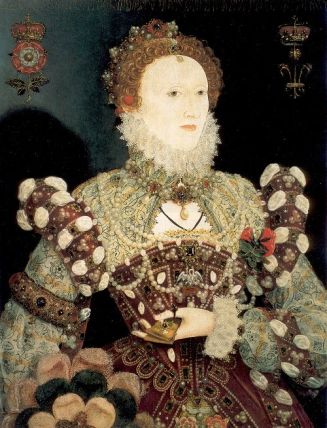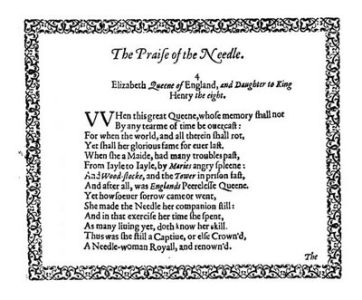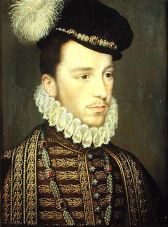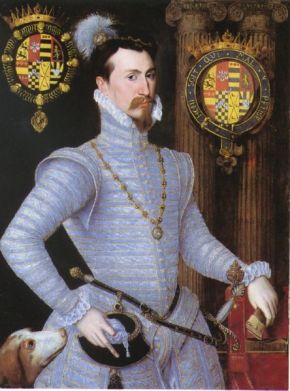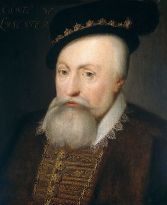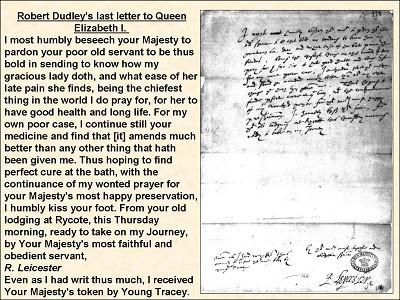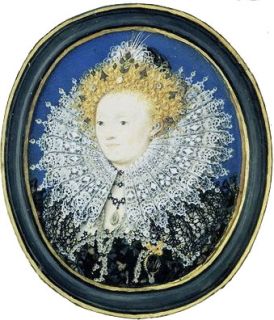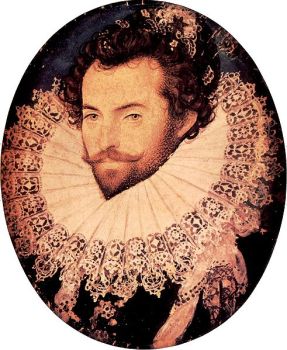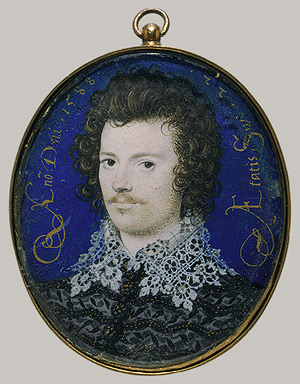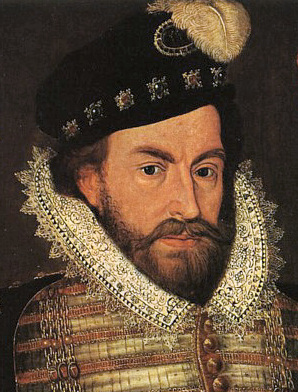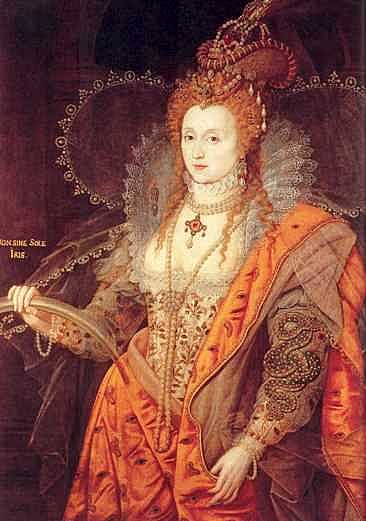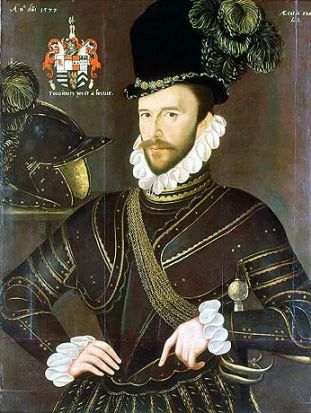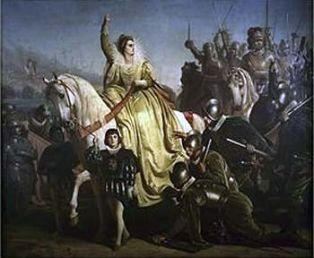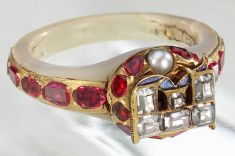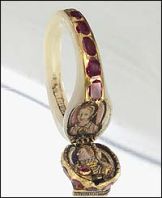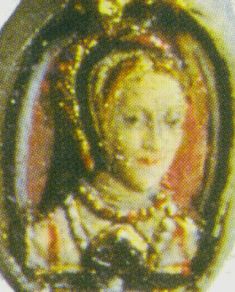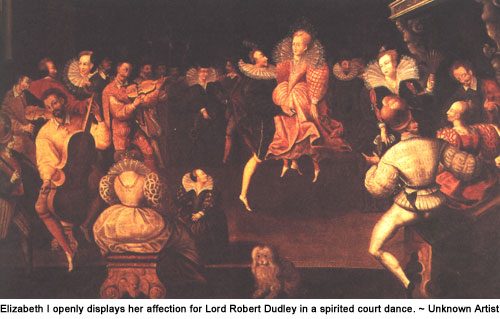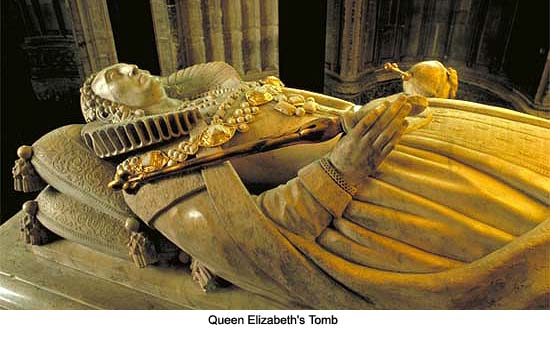Queen Elizabeth I - Historical profile
Jump to navigation
Jump to search
Literature
| | The History of Queen of England November 17, 1558 (aged 25) - till her death in March 24, 1603 (45 years) Want to add to this page? Click EasyEdit to update this page! (Don't see the EasyEdit button above? <a href="/#signin" target="_self">Sign in</a> or <a href="/accountnew" target="_self">Sign up</a>.) |
INTERESTING FACTS:
| c. 1560 Enemies: Mary, Queen of Scots - the granddaughter of Henry VIII's sister, Margaret, Queen of Scotland. She was a dangerous rival for Elizabeth because her Tudor descent gave her a claim to the throne and because she was a Roman Catholic, making her a useful alternative to those who opposed Protestantism. The French supported her for a time. King Philip II of Spain - husband of Queen Mary I. As the most powerful Catholic monarch in Europe, he was always dangerous to Elizabeth. The English defeat of his armada is considered a hugely significant event in Elizabeth's reign. However, it is interesting to note that he may have had a hand in lessening Mary I's anger towards Elizabeth during her time in the Tower. This is because he saw Elizabeth as a potential wife after Mary's death. Queen Mary I: It is important to mention that while Mary and Elizabeth were sisters, Mary was not necessarily as cruel to Elizabeth as it is popularly believed. Elizabeth's epitaph says that sisters they are and they will be reunited in death or in the coming of the day of resurrection. However, though both did share a sisterly affection in Elizabeth's younger years, Elizabeth's avoidance in taking part in Catholic Mass and ceremonies during Mary's reign affected their later relationship. Mary placed Elizabeth in the Tower after she learned of a Protestant plot to overthrow her in her sister's name, and Elizabeth reasonably feared for her life. She is reputed to have carved the following in a window at Woodstock Manor, Oxfordshire with a diamond:
1575 - 1580 Pelican Portrait by Hilliard
| ||||
| <embed height="269" src="http://widget.wetpaintserv.us/wiki/thetudorswiki/page/Princess+Elizabeth+Tudor/widget/youtubevideo/-1498597181" type="application/x-shockwave-flash" width="328" wmode="transparent"/> The story of Elizabeth through her Portraits. | Poem to Queen Elizabeth I, by john taylor | ||||
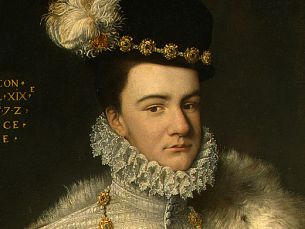 François, Duc d'Anjou - also called the Duke of Alençon. Elizabeth nicknamed him "frog" on account of a frog-shaped earring he had given her The only one of Elizabeth's many suitors to court her in person. The arrangement was proposed in 1579. He was 24 and Elizabeth was 46. Despite the age gap, the two soon became very close. Many opposed the match because he was French and Catholic. Elizabeth played the engagement game for some months but finally bid her 'frog' farewell in 1581. Neale observed, "Neither master nor servant was a match for the young woman at the diplomatic game of bluff. " However she did write a poem at this time which gave credence to the fact that she may have seriously considered the Duke as a potential husband. The poem is called : "On Monsieur's departure" I grieve and dare not show my discontent, I love and yet am forced to seem to hate, I do, yet dare not say I ever meant, I seem stark mute but inwardly do prate. I am and not, I freeze and yet am burned, Since from myself another self I turned. My care is like my shadow in the sun, Follows me flying, flies when I pursue it, Stands and lies by me, doth what I have done. His too familiar care doth make me rue it. No means I find to rid him from my breast, Till by the end of things it be supprest. Some gentler passion slide into my mind, For I am soft and made of melting snow; Or be more cruel, love, and so be kind. Let me or float or sink, be high or low. Or let me live with some more sweet content, Or die and so forget what love ere meant. Venetian Ambassador Giovanni Michieli acutely sensed Elizabeth's bluffing tactics when he wrote: "She has many suitors for her hand, and by protracting any decision keeps them all in hope, persuading herself that in her need they will do what they can from rivalry to gain her love and matrimonial alliance." For Elizabeth, courtships were a crucial element of her foreign policy and she would remain the most elusive bride in history . 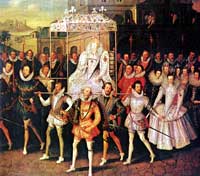 | Robert Dudley, Earl of Leicester b. c1532 - d 1588 (probably the one true love of her life) Guilford Dudley, husband of Lady Jane Grey was his brother. Elizabeth is quoted as saying : "You are like my little dog; when people see you, they know I am nearby." Robert said that "he knew her better than anyone else from when she was eight years old". He also added: "and from that age she always said that she would never marry". There were many rumours of intimacy between Robert & Elizabeth & it was recorded that she privately told him she would marry no one else. However, when Robert's wife Amy was found dead of a broken neck at the bottom of a stair case, many pointed the finger at him saying he had something to do with her death. Had the Queen married him, people would have believed the gossip, even that Elizabeth herself had been involved. Also, as Robert was hated because of his monopoly of royal favour, promoting him to prince consort may have provoked a rebellion against the Queen. However, for some years, it seems that both entertained the possibility of marriage, and Robert in particular continued to hope for it for many years. He did not remarry until 1578 when it seemed certain that the Queen would not marry him. In 1575, during the glorious entertainments at Kenilworth Castle, Warwickshire, Robert made his last proposal of marriage to the Queen. As she had done in the past, she refused him. Dudley in later years 1580 - 85 | ||||
| Sir Walter Raleigh b.c.1552 - died 1618 (66 yrs) (Elizabeth's nickname for him was 'Water') An outspoken man, Raleigh gained the notice of the Queen around 1580 when he criticised English policy in Ireland. Apparently his candid ways were gilded with charm, however, and he soon became a favourite of the Queen, who knighted him in 1585. As Elizabeth’s reigning favorite, he began to earn royal favors including vast amounts of land in Munster, wealth and influential positions, one of which was as the monopoly holder of licenses for ale of wines, export of broadcloths and warden of the Cornish tin mines. So powerful was Raleigh at this time that it was often assumed Elizabeth would marry him, for there seemed no favor too large for her to grant him. He became vice-admiral of Devon and Cornwall and had a seat in Parliament. He was ultimately captain of the queen’s guard, a position that many consider may have put him close enough to the Queen that more personal favors on her part were also part of his benefits. After Raleigh was appointed governor of Jersey in 1600, however, his fortunes became precarious. Raleigh apparently wanted a home, a wife and family, and after acquiring a house in Dorset, secretly married Elizabeth "Bess" Throckmorton, cousin of King Henry's sixth wife, Catherine Parr, and daughter of a noble family. When the jealous Queen discovered Raleigh’s duplicity after the couple had a child, she imprisoned both Elizabeth and Raleigh in the Tower of London. Always a ruthless survivor and manipulator, Raleigh bought his release with profits he’d made from a privateering voyage in which he’d invested. He was free, but never regained his influence at Court. | Robert Devereux, Earl of Essex b. 1565 - d. 1601 (36 yrs) In 1587 Robert Devereux was appointed master of the horse, and in the following year was made general of the horse and installed knight of the Garter. On the death of Robert Dudley, Earl of Leicester he succeeded him as chief favourite of the queen, a position which injuriously affected his whole subsequent life, and ultimately resulted in his ruin. While Elizabeth was approaching the mature age of 60 , Essex was scarcely 21. In May, 1587, a courtier reported, the Queen often had “nobody with her but my Lord of Essex; and at night my Lord is at cards, or new game or another with her, that he cometh not to his own lodgings till birds sing in the morning”. In 1593 Elizabeth appointed him to the Privy Council, the work horse of Tudor government staffed by her most trusted counselors. But Essex was too obvious and impetuous in his demands on the Queen. For every vacant office Essex had a candidate whom he urged upon the Queen with pressing importunity. There were stormy scenes between them once Elizabeth boxed his ears. In 1599, at his own demand, he was made lord lieutenant of Ireland and sent there with a large force to quell the rebellion.In 1600, Essex planned a coup that would oust the Cecil faction and establish his own about the Queen. To this end he sought support from the army in Ireland and opened negotiations with James VI in Scotland, but these efforts failed. Desperately, he made his attempt of rebellion with a small body of personal followers on 8 Feb 1601. The Londoners failed to respond, the Queen's government was thoroughly prepared, and he was arrested. At the trial Bacon contributed heavily to his former patron's conviction. Elizabeth, after some hesitation, signed the death warrant, and Essex was executed. | ||||
| Sir Christopher Hatton b.1540 -1591 (51 yrs) (Elizabeth's nickname for him was 'mouton' - sheep) Another great favourite of Elizabeth's and leading courtier who was involved in most of the important decisions of her reign. He was in daily contact with her and remained single until his death. He had one illegitimate son. During his last illness the Queen paid him several visits, and is said to have fed him with her own hands. He was buried with great pomp in St. Paul's cathedral in 1591. | c.1600 - the Rainbow Portrait | ||||
| Sir Francis Drake b. 1540 - d. 1596 (56 yrs) Elizabeth delivers her Speech at Tilbury <a class="external" href="http://www.iwm.org.uk/upload/package/41/women/sounds/Elizabethspeech.mp3" rel="nofollow" target="_blank" title="Click here to hear an audio clip of Elizabeth's speech">Click here to hear an audio clip of Elizabeth's speech</a> | Drake and the attack of the Spanish ArmadaDrake was Queen Elizabeth’s favorite sailor and, when news spread of a massive shipbuilding program being carried out in all the Spanish ports, she commissioned Drake to pay a visit to the largest Spanish port of Cadiz. In a thrilling 36-hour commando raid he looted and burned 30 ships. This delayed the sailing of the Spanish Armada by a year but it could not be halted permanently. In July 1588 Francis Drake was playing lawn bowls in the port of Plymouth when news arrived of the terrifying sight of 170 Spanish war ships. Cool as ever, Drake insisted on finishing the game before departing to the docks. The British did not know precisely where the Armada was heading but managed to get in behind the huge crescent shaped fleet and started picking off the outlying ships. As it happened the Armada was actually sailing for Flanders to pick up 17,000 Spanish soldiers (there to enforce Spanish rule in the Netherlands). With these soldiers on board, the Armada was then scheduled to attack England — but it was not to be. A series of disasters was about to strike the Spaniards. Firstly, when the Spanish Armada anchored at Calais the English fleet waited until dark and then borne by the wind and tide, floated in eight “fire ships.” These were unmanned ships stuffed with in-flammables and gunpowder. As the fire ships approached the tightly packed enemy fleet, the Spanish panicked. Anchor cables were cut and heavy galleons, troop transports and store ships collided with each other. At dawn the great Armada was scattered along the coast and the British were on the attack. Then a gale came up and the battered Armada had to run for it. Abandoning any idea of picking up the waiting troops or even attacking the English mainland, the fleet flew northwards along the English coast around North Scotland and down past Ireland. In dreadful weather and without anchors, ship after lumbering ship crashed into the rocky coast, and desperate Spanish sailors and soldiers crawled ashore only to be cut down by British troops and others waiting for them. Only about 40 of the once proud ships of the Armada got back to Spain and over 12,000 lives had been lost. Spanish domination of the Atlantic Ocean was over and the British could start claiming that “Britannia rules the waves.” Drake, who had played a major role in the Armada victory, tried to retire to Buckland Abbey but the lure of the Caribbean was too strong. With his old partner, Hawkins, he found himself back in the Panama area when, in 1596 at age 56, he caught a fever and died — much to the relief of Spain. The Dragon, the devil with the red beard, was gone! [source: Famouslives.com] |
| Above is the locket ring which belonged to Queen Elizabeth I. The ring bears the initial 'E' in table-cut diamonds and contains miniature busts of Elizabeth herself and the other of her mother, Anne Boleyn (to the right) | Miniature portrait of Anne Boleyn - inside the ring that her Daughter Elizabeth I constantly wore and was removed from her finger & after her death was sent to James VI of Scotland as evidence of her death showing how important the ring and her mother was to Elizabeth. |
UNFORGETTABLE QUOTES from Queen Elizabeth I during her reign:
|
Literature
Non-Fiction:
| Fiction:
|
